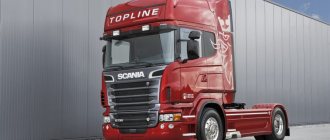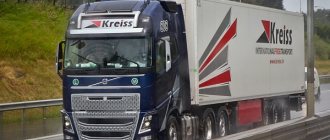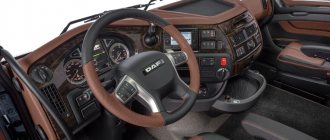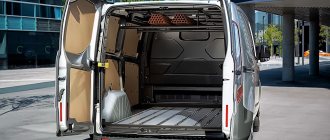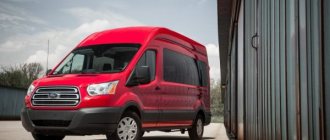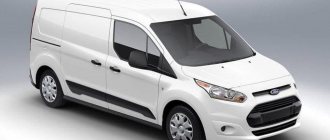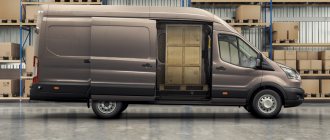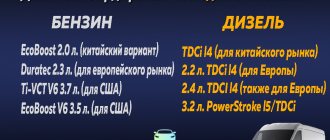Andrey Filippov, photo by the author
Sun, sea, Sochi. Good mood, great company and hundreds of kilometers of hospitable serpentines and recently built “Olympic” tunnels. What more could you want to get acquainted with the new Ford Transit?! Believe it or not, you need less choice of cars and less technical information! And if I have already learned how to narrow down the choice to the only correct and interesting “vehicle”, I have not yet been able to compress useful information into two succinct sentences...
The planned story about how I drove a new product on the Russian market faded into the background. But the first place has moved to the story of what we will ultimately see on our roads from what was so vividly and colorfully voiced at the European presentation of the model (“GP” No. 4, 2014).
One hundred clothes
Today there will be no excursions into history, listing achievements or even impressions of the past blitz test. I will only note that the new Ford Transit did not disappoint in any way - just minor quibbles, which will be discussed some other time. Today, information is for those who want to know what to expect and what to build on when planning to update their vehicle fleet, taking into account the new items from Yelabuga. Moreover, “our” Ford Transit has been approved for participation in public procurement tenders.
There are three body options: an all-metal van, a chassis and a minibus. The first are divided into types according to total length and height: L2H2, L2H3, L3H2, L3H3, L4H3. Did you notice? There will no longer be a version with a “low” roof. Now this standard size is the lot of the “younger” Custom.
In addition, vans have grown a little in size, especially for transporting indivisible goods. The most compact version now also accommodates four Euro pallets (2 along and 2 across), which allows 100% use of the body's capabilities. In addition, the loading length on the floor and with the cabin partition installed on the L2 is now 3044 mm. This means that a standard 3-meter indivisible cargo will accurately fit inside the cargo compartment.
Perhaps, along the way, I’ll preempt the question: “Why then the L3 version, which also takes four Euro pallets, but all across?” For the production of various special versions. The same refrigerator with thermal insulation walls cannot be mounted on L2 without reducing the number of Euro pallets, but on L3 - please!
The chassis has a different gradation: L1, L2, L4. And again it’s true, a wheelbase of 3137 mm has appeared, but there is no intermediate length L3 as unnecessary. In addition, by changing the shape of the cabin, the designers, while maintaining the dimensions of the base of the previous generation, managed to win back centimeters on the frame to accommodate the superstructure. Now the compact “city” versions will be more maneuverable, but the longest, “long-range” version now has a frame increased by 169 mm for a larger body.
Well, minibuses, I note that they are “factory” manufactured, are divided according to the number of seats into 9-seater and 18-seater. Moreover, thanks to the width of the sliding door opening - 1300 mm, the bus is approved for regular passenger transportation, despite the fact that its aft doors are blocked by a four-seat layout of the last row. Are you surprised? In vain - the sliding door is counted as a double door, which means it is also an emergency exit. Oh, and how many copies were broken by bodybuilders on all analogues without exception, and on the previous generation Ford Transit too, to solve the problem with the emergency exit. And the solution - here it is!
However, we have summarized the most key parameters in the example of all-metal vans, which are necessary for a general understanding of what we are talking about, in a table. I would like to separately note that the columns “Total weight”, “Curb weight”, “Load capacity” and “Weight distribution along axles” were deliberately excluded from the table. It turned out that the game of numbers here is almost indescribable and is very dependent on the type of drive, overall dimensions, etc. So if you are planning to buy a Ford Transit, be sure to consult with the manager. It will be more reliable this way.
Transit ownership
No matter how interesting external innovations are, for real life it is sometimes much more important how much the car has changed inside. Let's start with the proposed engines. The engine is essentially the same - Ford Duratorq 2.2 TDCi, but with different programmed power and different environmental class. Front-wheel drive is satisfied only with a transversely mounted 125-horsepower (350 N∙m) Euro 4 engine in combination with a 6-speed VMT-6 manual transmission.
Rear-wheel drive versions have more choice - 125 (E4), 135 (E5) and 155 hp. (E4), and 350, 355 and 385 N∙m, respectively. But if you look into it, you won’t be able to walk around here either. Vans (Van) and minibuses (Bus M2) are equipped only with an “intermediate”, 135-horsepower engine that meets Euro 5 standards and, naturally, requires the use of urea. And the chassis, depending on the size, will receive the remaining two options.
All-wheel drive versions also have no alternative – 125 hp, that’s all. As with rear-wheel drive cars, the MT-82 manual gearbox is used here.
By the way, I assume that almost everyone who used the previous version of the all-wheel drive Ford Transit will be able to say a few not very flattering words about this system, or more precisely, about the moment when the “front axle” is connected. According to Ford Sollers representatives, this problem has now been resolved.
If we go deeper into the nuances, now instead of a mechanical pump, an electric one is used to create oil pressure. A separate button for turning on all-wheel drive has appeared. The power flow is now supplied simultaneously to both front wheels. Well, the total weight of the structure (117 kg) is one of the best indicators in the class.
But we won’t describe the operation of electronic control and driver assistance systems. We’ll test everything personally, then we’ll draw conclusions, but for now let’s just note that there are a LOT of them, especially for a commercial van.
Well, and service, of course. Due to changes in the technology of fastening some units (the peak load during testing on ONE front wheel is 5600 kg), as well as the use of more modern materials in the manufacture of certain parts, the cost of maintenance as a whole... will decrease.
Are you surprised? Of course! In fact, everything is simple - the time required for maintenance has decreased. The most striking example: the time required to replace a rear brake disc has been halved and no longer requires the use of special tools. In addition, now the “consumables” themselves last longer, and although the frequency of maintenance has not increased, those who operate equipment in more severe conditions will notice this.
Salon
The interior of the cabin looks completely utilitarian, hard plastics are used here, there are huge gaps and extraneous sounds everywhere, but the level of comfort for front passengers and the driver is acceptable, and considering that this is a commercial vehicle, it is absolutely luxurious. The Ford Transit has three seats in front, there is no central tunnel, but there is a parking brake handle between the driver's seat and the passenger sofa.
Scattered throughout the panels are small and large niches that are necessary in this car, and there is also a large number of cup holders of different sizes.
In front of the driver is a 4-spoke steering wheel with a central part in the form of an inverted trapezoid. Behind the wheel is a simple and informative dashboard with large tachometer and speedometer scales, and between the scales there is a non-color display of the on-board computer. The center console is large; in its lower part there is a place for the gearshift knob, and in the central part for two air intakes, between which there is a control unit for an audio system with two speakers. Below is the air conditioning control unit.
The seats have a sufficient range of adjustments, good padding, but poor lateral support.
Intermediate finish
Let's summarize the preliminary results. The main and most important thing is the current Ford Transit. Unlike most competitors, this is not a restyling, not a facelift, not a modernization - this is a completely NEW generation of LCV. Moreover. It is now divided according to functional characteristics not only by size, but also by model - yes, yes, Ford Custom, despite the fact that it is completely different from the Ford Transit, is still formally a “small” branch of the family.
The first conclusion is that Transit has sharply increased its attractiveness in terms of its “uncluttered” appearance, which makes the car stand out from the traffic flow. And this is, after all, hidden advertising for the company using it.
From the fact that the presented generation is fully “new”, the second conclusion immediately follows - the Transit design was initially designed taking into account all new achievements, discoveries and trends, both in terms of ergonomics and safety and environmental friendliness.
Well, the third most significant point for many: the new generation of Ford Transit not only kept the same price... it became CHEAPER!!!
All-metal vans cost 44,000 rubles, passenger versions, traditionally called “Kombi M1,” cost 84,000 rubles, and chassis cost 140,000 rubles, of course, we are talking about similar configurations. And I have already spoken about the general reduction in the cost of service. Conclusion three – no comment. Technical characteristics of Ford Transit VAN (general data)
| Modification | L2H2 | L2H3 | L3H2 | L3H3 | L4H3 |
| Wheelbase, mm | 3300 | 3750 | |||
| Overall dimensions, mm | 5531x 2474x 2550 | 5531x 2474x 2789 | 5981х 2474х 2547 | 5981х 2474х 2786 | 6704х 2474х 2781 |
| Capacity, m3* | 9,3** | 10,3** | 10,8** | 12,0** | 14,1** |
| Suspension | The front is an independent MacPherson type, with coil springs of variable stiffness, shock absorbers and a stabilizer. Rear - dependent, spring with shock absorbers | ||||
| Brake system | Double-circuit, with disc brakes | ||||
| Wheel formula, drive type | 4x2 (front), 4x2 (rear), 4x4 | 4x2 (rear) 4x4 | |||
| Minimum turning radius, m | 11,9 | 13,3 | |||
| Fuel tank capacity, l | 80 | ||||
* For front-wheel drive versions.
** If there is a partition between the cabin and the cargo compartment.
Looks a lot like an advertising campaign, doesn't it? We thought so too, but... In response to a direct question from journalists: “If your new generation consists of only advantages, including price, and we write about this, then how are you going to sell off the remnants of the old one, of which there is still plenty in warehouses?” - Ford Sollers representatives answered with a smile: “The main thing is, tell everyone about the new Ford Transit, and we’ll sort out the sale of the old one ourselves.”
Well - feel free! Especially in light of the fact that, as a result of the blitz acquaintance, the new generation of Transit, based on a combination of factors, came to the top of my personal rating of LCVs present on the Russian market. At the same time, there were much more questions about the previous generation.
We are waiting for a full test drive to dot all the i's...
Tales for VIP
But what about bodybuilders, who usually “on the fly” grasp all the more or less promising market models?
Did they really miss out on the new Ford Transit since the presentation included only factory all-metal vans?! No matter how it is! Back at the end of September, I found several different add-ons installed on the chassis of the new Ford Transit on the territory of ST-Nizhegorodets LLC. Moreover, an all-metal van similar to those in our familiarization test was also spotted there. We are waiting for the final premieres...
Main malfunctions of technical components
The technical components have proven to be reliable, but the van also has some shortcomings, for example, the installed motors refuse to work in cold weather without good warming up, and it is also difficult to start the internal combustion engine in cold weather, so pre-heating is indispensable. Often the speed starts to fluctuate. The reason is a clogged EGR valve. Picky about fuel quality. It is not worth pouring with a cetane number below 51. In Russia it is difficult to find original spare parts for technical units.
Steering rods last no more than 80,000 km.
The disadvantage is considered to be the suspension, which will have to be completely rebuilt before 140,000 km.


